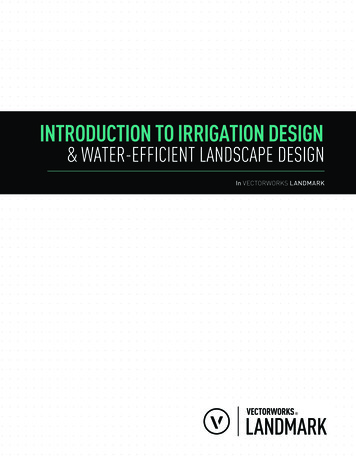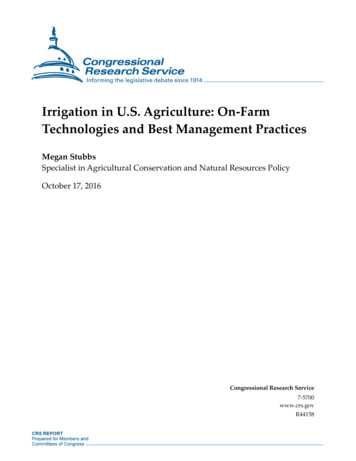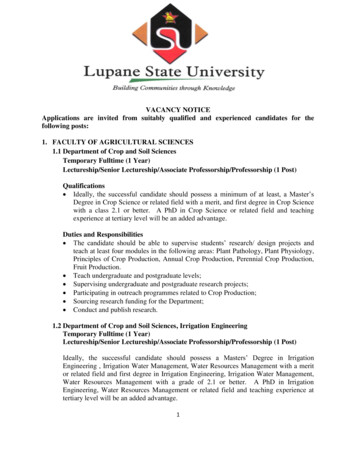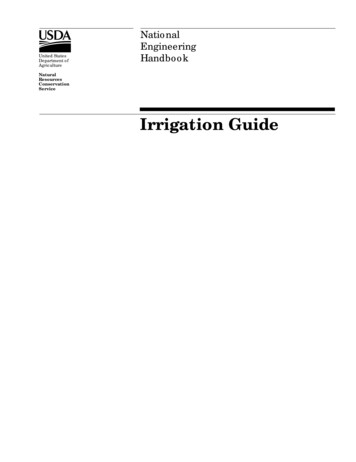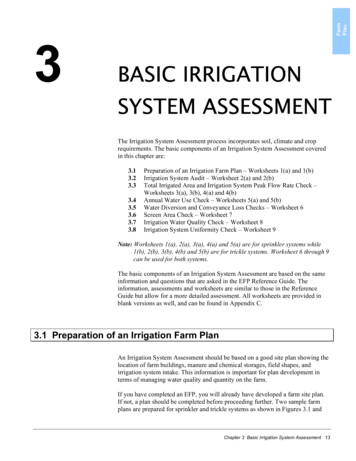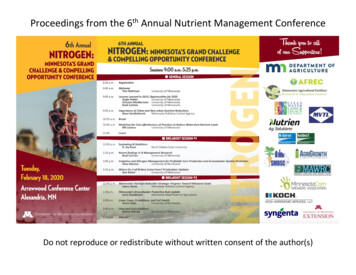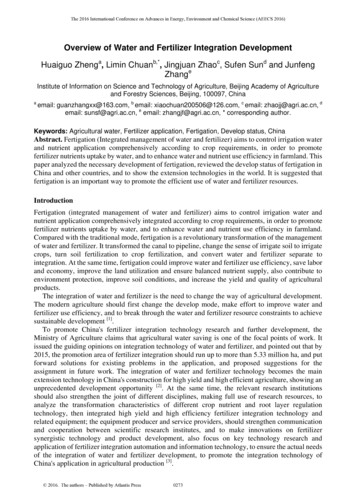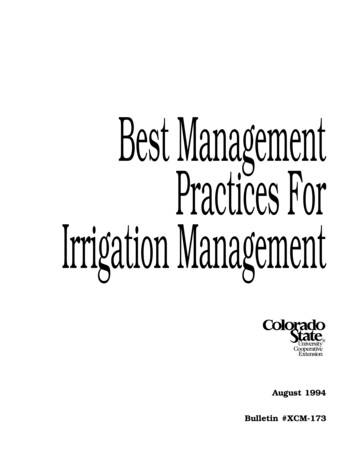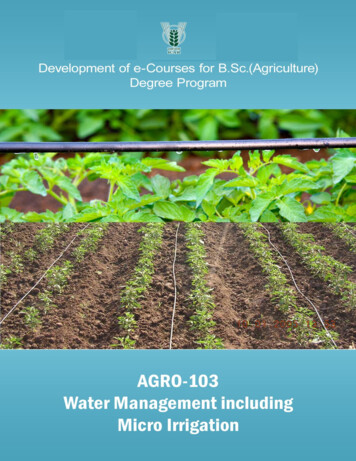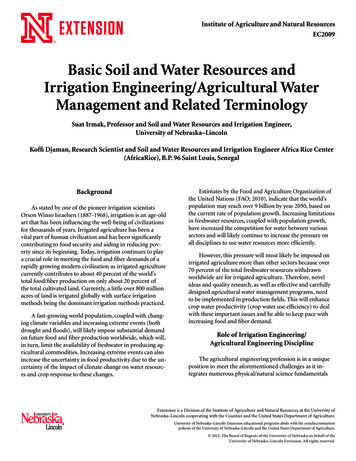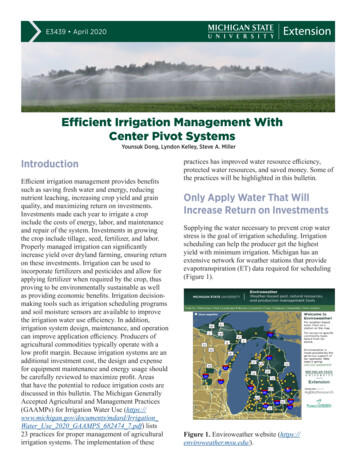
Transcription
E3439 April 2020Efficient Irrigation Management WithCenter Pivot SystemsYounsuk Dong, Lyndon Kelley, Steve A. MillerIntroductionEfficient irrigation management provides benefitssuch as saving fresh water and energy, reducingnutrient leaching, increasing crop yield and grainquality, and maximizing return on investments.Investments made each year to irrigate a cropinclude the costs of energy, labor, and maintenanceand repair of the system. Investments in growingthe crop include tillage, seed, fertilizer, and labor.Properly managed irrigation can significantlyincrease yield over dryland farming, ensuring returnon these investments. Irrigation can be used toincorporate fertilizers and pesticides and allow forapplying fertilizer when required by the crop, thusproving to be environmentally sustainable as wellas providing economic benefits. Irrigation decisionmaking tools such as irrigation scheduling programsand soil moisture sensors are available to improvethe irrigation water use efficiency. In addition,irrigation system design, maintenance, and operationcan improve application efficiency. Producers ofagricultural commodities typically operate with alow profit margin. Because irrigation systems are anadditional investment cost, the design and expensefor equipment maintenance and energy usage shouldbe carefully reviewed to maximize profit. Areasthat have the potential to reduce irrigation costs arediscussed in this bulletin. The Michigan GenerallyAccepted Agricultural and Management Practices(GAAMPs) for Irrigation Water Use onWater Use 2020 GAAMPS 682474 7.pdf) lists23 practices for proper management of agriculturalirrigation systems. The implementation of thesepractices has improved water resource efficiency,protected water resources, and saved money. Some ofthe practices will be highlighted in this bulletin.Only Apply Water That WillIncrease Return on InvestmentsSupplying the water necessary to prevent crop waterstress is the goal of irrigation scheduling. Irrigationscheduling can help the producer get the highestyield with minimum irrigation. Michigan has anextensive network for weather stations that provideevapotranspiration (ET) data required for scheduling(Figure 1).Figure 1. Enviroweather website (https://enviroweather.msu.edu/).
Efficient Irrigation Management With Center Pivot SystemsOver the years, technology has been developed toassist in irrigation water management. Soil moisturesensors have been used to improve the water andfertilizer use efficiency, which can increase cropproduction. Sensors provide greater insight into waterneeds and can inform better management throughprecise irrigation scheduling. In addition to the watersavings, the use of soil moisture sensors can reducenitrate leaching (loss of nitrogen fertilizer) belowthe root zone. Figures 2 and 3 show soil moisturemonitoring systems.Page 2Some of the GAAMPs related to this section include: Avoid applying irrigation water in excessof the quantity of water needed to replacethe soil/substrate moisture deficit in the rootzone.Know the depth of rooting for each cropirrigated.Know the allowable soil moisture depletionat each stage of crop growth.Measure, estimate, or use published evapotranspiration data and crop co-efficient (whenavailable) to determine crop water use.Measure rainfall in each field irrigated.(Michigan Department of Agriculture and RuralDevelopment, 2020, pp. 5–8)Apply Ideal Irrigation VolumeA list of irrigation best practices follows. Figure 2. Soil moisture monitoring system in a seedcorn field. Never irrigate below the root zone. Figure4 shows an example of soybean root systemdevelopment at different crop stages. Findother crop’s root system development on theMichigan State University (MSU) Irrigationwebsite s-root-system-development).Provide water to at least the top half of theroot mass.Make individual irrigation applications largeenough to minimize the number of timeswetting the crop and soil surface.Figure 3. Soil moisture sensor monitoring.Figure 4. Soybean root development at different cropstages.
Efficient Irrigation Management With Center Pivot SystemsUse the Biggest IrrigationApplications Possible WhileAvoiding RunoffTo make the best use of irrigation water, producersshould try to provide 4 or 5 days worth of crop wateruse per application, typically 1 to 1.25 inches at peakwater use periods. These larger irrigation applicationsincrease the amount of effective water available to thecrop by reducing the water lost by evaporation in thecrop canopy and on the soil surface. Regardless ofthe amount of irrigation water applied, approximately0.1 inches is lost per application when the crop is ina mature canopy. Irrigators with center pivots thatapply water faster than the water can infiltrate intothe soil should use smaller applications (less than 0.5inches) to avoid runoff. Find infiltration rates for soiltypes on the MSU Irrigation website -infiltration-rate).Page 3Optimize Late Season IrrigationLack of water in the late season can result in low testweight corn and undersized soybean in uppermostpods. Applying irrigation until the crop reachesmaturity is important to maintain or increase thequantity and quality of the crop. The irrigator shouldmaintain at least 40% of the available soil waterholding capacity until: Corn reaches black layer.Most pods turn yellow for soybeans (Figure 6).However, late in the season the crop requires lessirrigation as the weather is generally cooler anddays are shorter. There is also greater chance ofprecipitation.The GAAMP related to this section follows: Assure that sprinkler application rates arebelow the soil infiltration rate in order toprevent runoff and accumulation of waterin lower areas, which may result in excessinfiltration and leaching.(Michigan Department of Agriculture and RuralDevelopment, 2020, p. 10)Factors that increase runoff include sprinklers withsmall wetted area, larger application volumes, soilcompaction, heavy soils, slope, and row hilling(Figure 5).Figure 6. Most of soybean pods turn yellow.Evaluate the Irrigation SystemFigure 5. Runoff caused by larger application onheavy soils.Some practices that can save water, energy, and costfor irrigation systems follow. Evaluation of irrigationsystem uniformity is critical. The area affected bynon-uniform irrigation applications will becomemuch larger with increasing the number of irrigationapplications. For example, a 30% deviation during aseason that would require 8 inches of supplementalirrigation will have areas receiving as little as 5.6
Efficient Irrigation Management With Center Pivot Systemsinches and as great as 10.4 inches. Typically, a 10%or less deviation from the average is ideal, but 15%is acceptable. When designing a center pivot system,additional nozzles–a relatively small investment–can increase the uniformity. Kelley (2014) hasdescribed the procedure for testing the uniformityof the center pivot (Figure 7). Kelley and Anderson(2019) demonstrated the use of an Unmanned AerialVehicle (UAV) (Figure 8) to inspect the uniformity ofirrigation systems.Page 4The irrigation system should be periodicallyinspected for clogged nozzles and emitters, leakypipelines, and riser gaskets among other components(Figure 9). Deep percolation from leaking pipes couldleach nutrients or chemicals to groundwater. Read thepressure gauge at the center pivot regularly to identifythe potential problem with the system.Figure 9. Pressurize the system and inspect forleaks, holes, and damaged sprinklers. Use a crayonmark, flag, or photo to identify the needed repair. Thequicker the repair is made, the lower the crop damageincurred at the site.Some of the GAAMPs related to this section include:Figure 7. Catch can test to check uniformity of thecenter pivot system. Evaluate the irrigation system uniformity.Keep records on all system inspections andrepairs that influence uniformity and leaks.Maintain the irrigation system in goodworking condition.(Michigan Department of Agriculture and RuralDevelopment, 2020, pp. 3-4)Choose the Right SprinklerPackageFigure 8. UAV to inspect the uniformity of the centerpivot system (Photo Credit: Eric Anderson, MSUExtension Educator).When choosing a sprinkler system, water loss byevaporation is only a minor concern in Michiganwhere the relative humidity is high. However, runoffis a significant issue in irrigated fields with steepslopes.
Efficient Irrigation Management With Center Pivot SystemsThe considerations for selecting the sprinkler include: Greatest wetted area and pressure requiredMost uniformEasily updated nozzle packageGreatest tolerance of pressure changeWind driftSprinkler spacingChemigationPressure regulationFind more details on selecting the sprinkler packagefor a system in the University of Nebraska–LincolnExtension bulletin Converting Center Pivot SprinklerPackages: System Considerations (G1124) .Consider Variable Rate IrrigationVariable rate irrigation (VRI) controls the speedof the pivot to apply varying volumes of water tospecific sections of the field. A simple and relativelyinexpensive option is the speed control, available inmost center pivot systems. Speed control VRI benefitsproduction when: There are multiple crops and soil textures inthe field.There is relatively inexpensive cost comparedto zone or sprinkler control VRI systems.It is allowable to add speed control on theexisting center pivot.The speed control VRI can only control applicationsin pie slice-shaped parcels.Zone or sprinkler control VRI systems can adjust theapplication rates of individual nozzles. A producercan adjust these parameters at multiple points alongthe path of the pivot circle using GPS. The benefitsof the zone or sprinkler control VRI systems are mostapparent when: There are two or more soil textures in thefield since soil texture plays a major role indetermining water holding capacity.Multiple crop species, crops with differentplanting dates, or crops with different Page 5maturities are grown under a single irrigationsystem since evapotranspiration rates will bedifferent for these situations.There are areas where irrigation is unnecessarysuch as ditches, farm lanes, and woodlots.Considerations for zone or sprinkler control VRI include: Complex systemMore expensiveAdditional maintenance and managementFind detailed information on VRI in the Universityof Nebrasks-Lincoln Extension bulletin VariableRate Application of Irrigation Water With CenterPivots (EC2000) -with-center-pivots/).Use Fertigation or Split NitrogenApplication to Maximize YourReturnIrrigated production has the advantage of fertigationas an option in nitrogen (N) management. Fertigationis the process of applying fertilizer through irrigationwater. Urea ammonium nitrate is the most commonproduct for fertigation with proper equipment. From amanagement standpoint, fertigation allows producersthe opportunity to evaluate crop stands, N losses dueto wet conditions or heavy rains, and current marketconditions to adjust their N management plan to meetcrop needs, maximize profitability, or do both. Thecloser the N fertilizer is applied to the time of peakcrop need, the lower the potential for N loss, and thegreater the return for your N investment.Even if you never fertigate, irrigation still providesthe opportunity to water in surface applied or knifedin N applications. Incorporation by irrigation reducesN loss to vaporization, increasing the usable amountof N for the crop.Some of the GAAMPs related to this section include: When irrigation is used, split application ofnitrogen fertilizer or use controlled releasefertilizer.
Efficient Irrigation Management With Center Pivot Systems Incorporate appropriate backflow-preventionsafety devices if a chemigation system is used.(Michigan Department of Agriculture and RuralDevelopment, 2020, p. 11)Automation of an irrigation system can be anextra expense at a time when budgets are tight,but interlocking pumps and center pivots or otherdistribution systems can be done for under 500and can avoid overwatering when the pivot stops orapplication cycle ends.The GAAMP related to this section follows: Irrigation systems used for applyingchemigation should have adequate interlockand safety systems to prevent overapplicationof pesticide, fertilizer and water when pumpscontinue to run and the distribution systemstops moving. Page 6later, repairing any tire that lost pressure(Figure 11).Observe each center pivot drive motorand drive gearbox while running, drainaccumulated water, check oil levels, and refill.Growling and grinding sounds indicate theneed for replacement or repair.Dealing with these issues before planting reducesthe need for expensive repairs and minimizes startupdelays or downtime during the middle of the growingseason. The added benefit of being ready to irrigateto aid in germination and emergence, incorporatefertilizer, or activate herbicide often leads to a betterstart to a profitable year.(Michigan Department of Agriculture and RuralDevelopment, 2020, p. 11)Maintain Irrigation Equipment toMinimize Expensive RepairsIrrigation technicians and service providers agree thatpreventative maintenance and precautionary startupprocedures can help avoid future costly repairs.Recommendations include: Remove mice, insects, vermin, and their nestsand waste. Close access to electrical controlboxes before spring startup (Figure 10).Clean and inspect the function of electricdisconnect boxes and well starter systems.Test center pivot-end stop controls and stopstructures before the first run.Test traveler-end run-stop control systembefore the first run.Trim or remove trees and brush that are nearthe pivot-end boom’s travel path.Inspect tires early in spring, add air tospecification, and recheck a couple of weeksFigure 10. Mice, snakes, and other small verminsqueeze into electric boxes for shelter.Figure 11. Tires are ruined quickly if run while low orflat. The pivot does not move normally with a flat tire,which may apply more water.
Efficient Irrigation Management With Center Pivot Systems“The Generally Accepted Agricultural andManagement Practices (GAAMPs) for Irrigationare based on the core principle of stewardship.Stewardship in irrigation management includesstewardship of water quantity, water quality, soil,plant quality, and crop yield. Stewardship of the water quantity means usingwater as efficiently as possible while providingfor the crop/landscape water needs. Utilizingmore water than necessary for production of aquality crop is wasteful of the water resourceand can have negative environmental andproduction impacts resulting from leaching ofnitrogen and possibly pesticides. With certainexceptions, over-irrigation is when waterapplications exceed the quantity needed toreplace the soil/substrate moisture deficit. Theamount of irrigation water to apply generallyis equal to the total evapotranspiration sincethe last irrigation minus any precipitation thatoccurred during the period.Stewardship of the water quality means beingcareful to apply water at a rate that willinfiltrate uniformly into the soil/substrateand be properly stored for crop use while notcausing surface runoff or water movementbelow the root zone.Stewardship of the soil means followingmanagement practices that will sustainand improve soil surface infiltrationcharacteristics and soil moisture holdingcapacity through increasing organic matterlevels and biological activity while reducingcompaction.Stewardship of the crop means managingwater to promote plant establishment, sustainplant development, and foster the long-termsustainability of the managed landscapesystem. Page 7Stewardship of the agricultural sector of theMichigan economy means producing highquality crops that maintain and enhanceMichigan’s reputation as a superior supplierin the marketplace.”(Michigan Department of Agriculture and RuralDevelopment, 2020, p. 1)
Efficient Irrigation Management With Center Pivot SystemsPage 8ReferencesResourcesKelley, L., & Anderson, E. (2019) Camera or dronevideo can help identify center pivot sprinklerrepairs. Michigan State University an GAAMPs: n Water Use 2020GAAMPS 682474 7.pdfKelley, L. (2014). Evaluating irrigation systemuniformity. Michigan State University Extensionand Purdue University Extension. chigan Department of Agriculture and RuralDevelopment. (2020, January). GenerallyAccepted Agricultural and ManagementPractices for Irrigation Water Use. nWater Use 2020 GAAMPS 682474 7.pdfMichigan State University Biosystems & AgriculturalEngineering Irrigation: gan State University Extension versity of Nebraska–Lincoln Extension,Converting Center Pivot Sprinkler Packages: SystemConsiderations ( G1124): versity of Nebrasks-Lincoln Extension,Variable Rate Application of Irrigation Water WithCenter Pivots (EC2000): with-center-pivots/MSU is an affirmative-action, equal-opportunity employer, committed to achieving excellence through a diverse workforce and inclusive culture that encourages all peopleto reach their full potential. Michigan State University Extension programs and materials are open to all without regard to race, color, national origin, gender, genderidentity, religion, age, height, weight, disability, political beliefs, sexual orientation, marital status, family status or veteran status. Issued in furtherance of MSU Extensionwork, acts of May 8 and June 30, 1914, in cooperation with the U.S. Department of Agriculture. Jeffrey W. Dwyer, Director, MSU Extension, East Lansing, MI 48824.This information is for educational purposes only. Reference to commercial products or trade names does not imply endorsement by MSU Extension or bias against thosenot mentioned. Produced by MSU Extension Educational Materials Team. 1P-04:2020-WEB-PA/BH WCAG 2.0 AA
irrigation as the weather is generally cooler and days are shorter. There is also greater chance of precipitation. Figure 6. Most of soybean pods turn yellow. Evaluate the Irrigation System Some practices that can save water, energy, and cost for irrigation systems follow. Evaluation of irrigation system uniformity is critical. The area affected by
